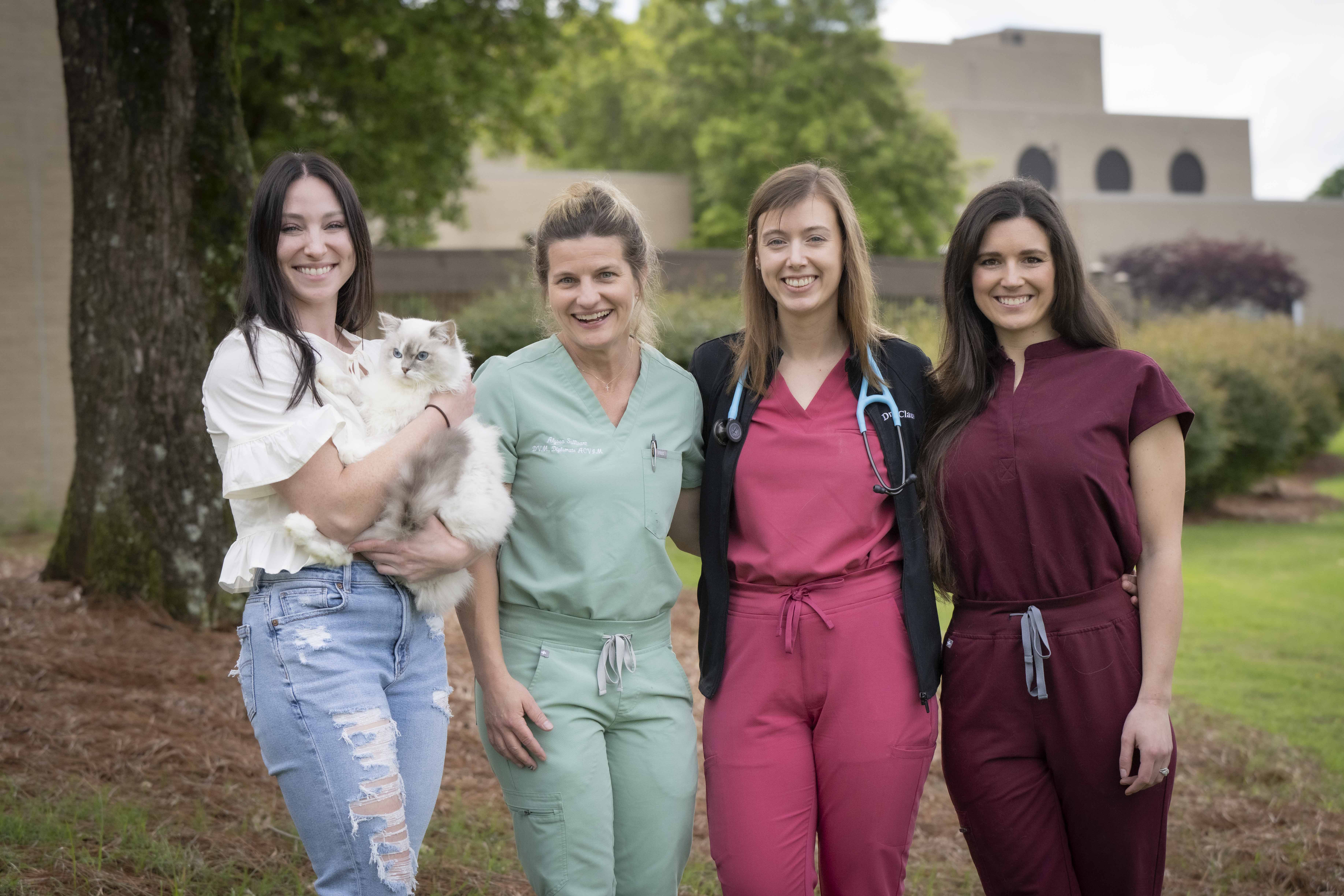By Livingston Sykes
When 6-month-old Ragdoll kitten Lumi arrived at the MSU College of Veterinary Medicine’s Animal Health Center, her owner was looking for an answer, and it turned out to be anything but typical.
What started as a simple bath at home ended with Lumi’s owner noticing unexplained bruising. A visit to her local veterinarian revealed dangerously low platelet levels—a condition known as thrombocytopenia, which hinders the blood’s ability to clot. Given the condition's complexity and her young age, Lumi was referred to the AHC for advanced diagnostics and care.
Lumi’s case initially puzzled the AHC clinicians. She lives indoors, has a healthy littermate, Esme, and had previously undergone surgery without complications. The ICU and internal medicine teams quickly went to work, conducting extensive lab work, imaging, and a bone marrow biopsy. The results showed that Lumi’s body was trying to make platelets, but they weren’t circulating. This pointed to a rare, immune-mediated thrombocytopenia with megakaryocytic dysplasia.
Further advanced testing confirmed the diagnosis, and the team began aggressive immunosuppressive treatment. Lumi received several whole blood transfusions from feline donors in MSU CVM’s in-house blood bank. However, complications escalated quickly. Lumi began reacting poorly to the transfusions, despite compatibility testing suggesting they were safe. As a Ragdoll with the rare AB blood type, Lumi was believed to be a universal feline recipient—but her reactions told a different story.
“She really should’ve tolerated the transfusions well,” said Dr. Rachel Claus, an Internal Medicine resident and one of the veterinarians on Lumi’s care team. “We started to suspect she was reacting to lesser-known blood antigens. There are at least six recognized in cats, and it’s possible Lumi was sensitive to one of those.”
After several reactions, the team decided to limit further transfusions and pivoted to an alternative therapy: human intravenous immunoglobulin (IVIG), a treatment more commonly used in people with autoimmune diseases. The product was obtained from OCH Regional Medical Center and rushed to the AHC for use. Despite their hopes, Lumi’s IVIG infusion was cut short due to internal bleeding and a sudden drop in vital signs.
By this point, Lumi’s packed cell volume had fallen to a life-threatening 9%. Her owners, always by her side, had already brought her littermate, Esme, in case an emergency donation was needed. Even so, Lumi experienced a severe transfusion reaction to her own sister’s blood. “We were shocked,” said Claus. “Her sister’s blood should’ve been the safest option.”
Lumi’s condition remained critical. She had no platelets—literally zero—in circulation for over two weeks. Desperate for options, the team tried vincristine, a form of a chemo agent that can combat the immune destruction of platelets, which then gives the platelets that are produced a chance to circulate without getting destroyed. While rarely used in cats and not without risk, it offered a glimmer of hope. Lumi developed temporary neurologic signs after the vincristine was given, but thankfully, they resolved.
Later, in yet another unorthodox effort, Lumi received a transfusion of canine blood—a stopgap solution not intended for long-term use, but one she surprisingly tolerated better than expected. With her platelet count still at zero and concerns growing about potential brain bleeding, Lumi’s care team opted for a last-ditch treatment to save her: StablePlate, a product no longer on the market containing the active components of platelets but not the cells themselves. Used only with her owners’ consent, it was a compassionate-use decision made in the face of few—if any-- remaining options.
And then, Lumi turned a corner.
The very next morning, her platelet count began to rise. Over the following days, it shot up into the high range before normalizing. However, just when discharge seemed imminent, Lumi developed sudden jaundice. Imaging and testing revealed a likely hepatic infection due to her severely immunosuppressed state. Thanks to restored platelet counts, the team could safely perform liver aspirates, confirming the suspected infection, and she responded quickly to antibiotics.
“Everything we tried, she reacted to,” said then fourth-year student MaryHolly Castro, who was on the case. “Every time we thought she was ready to go home, something else happened. But she kept fighting—and so did we.”
MaryHolly cared for Lumi through every twist and turn of her treatment and formed a deep bond with the unconventional patient. “I literally love that cat so much,” she said. “She was severely sick the whole time she was here, but you’d have never known it by looking at her. She’s a real trooper; she just didn't act sick.”
Lumi quickly became a favorite patient. Typical of the Ragdoll breed, she was relaxed, social, and unfazed by all the hustle and bustle of the clinic. She’d lounge over the edge of a table for hours watching dogs walk by, ride around on MaryHolly’s shoulder eating food “like it was a to-go order,” and show off her fluff after being brushed. “She genuinely seemed to know she looked good after a grooming; she would strut around like she knew she was the prettiest cat here,” MaryHolly said.
Thanks to MaryHolly, Lumi even has her own harness now. What started as a joke from Lumi’s owner, “Can you teach her to walk on a leash?” turned into reality once it became clear Lumi wasn’t going home anytime soon.
“She’s just a once-in-a-lifetime cat,” MaryHolly said. “She’s sweet, hilarious, chill, and just full of personality. Everyone here—doctors, students, techs—adore her.”
Lumi is now clinically stable, and although she remains on immunosuppressive medications and will have to return for regular follow-ups, her future is bright.
“There was a time we didn’t think we’d get here,” Dr. Claus said. “Her owners never gave up. They asked questions, stayed informed, and trusted us even when nothing was going right. We’re so grateful for the outcome; we’re just so happy we got to tell them they could take her home!”

